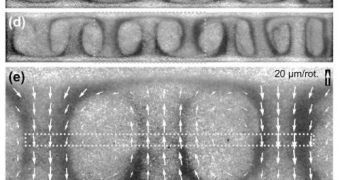According to physicists, there is currently no scientific explanation available for the results of experiments involving placing beads inside small, narrow and spinning boxes. The patterns that are formed are very beautiful and intriguing indeed, but they cannot be explained by basic science, and merit further investigation. A new paper detailing the peculiar behavior, entitled “Convection Rolls in a Rotating Box Filled with Beads,” is published online on the arXiv webpage, Technology Review informs.
German researchers from the University of Magdeburg Department of Nonlinear Phenomena, led by experts Frank Rietz and Ralf Stannarius, have recently found a new corollary to an older theory attempting to explain bead behavior. Japanese researcher Yositisi Oyama showed in 1939 that various patterns of segregation appeared in a rotating drum half-filled with beads of different sizes. The work started an entirely new field of research, that of the behavior of granular fluids. Since then, many research teams around the world have concentrated their efforts on studying new states of matter that may arise from the strange behavior.
Only recently, there was a new study that argued that the flow of sand could be considered a fourth state of matter. The stuff flows in grains, but these grains adhere to each other like liquid, a new set of super slow-motion videos has demonstrated. In their corollary, the German researchers do not place the beads in a rotating drum, but in a flat, narrow box, which is then rotated at a small speed, so as to minimize the inertial effects. The scientists note that, when the box is filled above a certain threshold, a rich pattern of convection movements appears in the beads.
Rietz and Stannarius reveal in a video that they were unable to explain the patterns that were formed using the standardly known mechanisms of granular convection. Therefore, they have no clue as to where these patterns come from, and how they emerge. Finding the answer to such questions may benefit a seemingly unrelated domain, namely that of planetary sciences. At a global level, the tectonic plates are navigating their sea of magma driven entirely by convection currents. Their paths and patterns determine where the next mountain chain will appear, and also where the next earthquake will take place.

 14 DAY TRIAL //
14 DAY TRIAL //